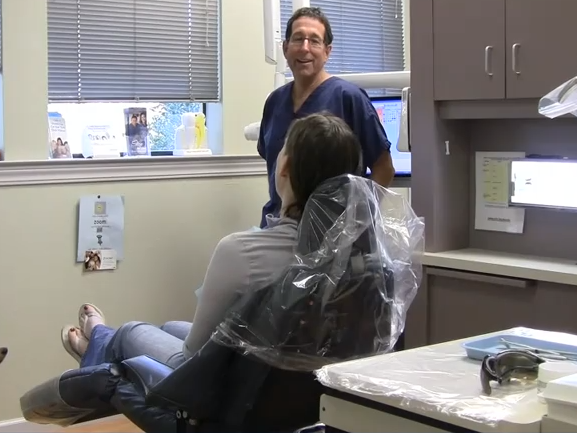Everyone knows flossing is an important part of dental hygiene, but many people are confused about what type of floss to use. The sheer amount of options can be overwhelming, which is why it’s a good idea to have some basic knowledge before making a decision.

Ask your dentist what type of floss is right for your teeth. Photo: Richard F. Sellman, D.D.S. (2014)
Fundamentally, there are two types of dental floss: nylon and monofilament. While nylon has been the standard dental floss for some time, monofilament floss is a more recent technology that consists of rubber, plastic or polytetrafluoroethylene (PTFE). Both nylon and monofilament flosses are available as waxed or un-waxed and come in a variety of flavors.
Some dentists insist that waxed floss doesn’t provide enough abrasion to effectively remove plaque, but according to the American Dental Association, recent studies show that there’s little difference in the effectiveness of either floss when used regularly. If you’re concerned about the effectiveness of your floss, woven nylon is a sure bet because it’s equally flexible and abrasive. However, while woven floss is particularly beneficial for those with normal to widely spaced teeth, those with more compacted teeth may experience discomfort and find the floss prone to tearing or shredding. In this case, monofilament floss may be a better option, as its synthetic composition precludes tearing and enables it to glide easily between teeth.
In addition to nylon and monofilament flosses, there are alternatives such as disposable flossing picks and water flossers. Disposable flossing appliances are generally regarded as less effective than traditional floss because they don’t allow for the same angular flexibility in getting around teeth. On the other hand, those who have difficulty reaching their back teeth or experience discomfort wrapping floss around their fingers may benefit from this option. Likewise, a water flosser is a fine supplementary tool, but it’s not a good substitute for regular flossing because water doesn’t have the same abrasive qualities as floss and is less effective at removing plaque.
While there’s no absolute answer as to which floss is best, the general consensus in the dental industry is that the best floss is the one you’re most likely to use. Dentists are less concerned about the style of floss you use and more concerned that you floss regularly.
To find a Diamond Certified dentist in your area, click on one of the links below.
Alameda County: www.diamondcertified.info/alameda-dentists
Contra Costa County: www.diamondcertified.info/contra-costa-dentists
Marin County: www.diamondcertified.info/marin-dentists
San Francisco: www.diamondcertified.info/san-francisco-dentists
Santa Clara County: www.diamondcertified.info/santa-clara-dentists
Solano County: www.diamondcertified.info/solano-dentists
Sonoma County: www.diamondcertified.info/sonoma-dentists
6 Responses
Leave a Reply
You must be logged in to post a comment.

I am someone to tends to choose flossing picks over traditional floss for the same reason as what is mentioned in the article, it can be difficult to reach the back teeth with traditional floss. I often feel like I would need to fit both of my hands entirely in my mouth to properly floss my back teeth with traditional floss. One thing I hadn’t considered, however, is that flossing picks do limit the angles that are possible to achieve with the floss, as mentioned in the article.
I’ve always wondered if there was a benefit from using a different kind of floss. My sister uses a really fibrous woven floss, but that has never worked for me because it gets stuck between my teeth. I like the monofilament floss best, but I did use flossing picks when I broke my hand. The picks worked ok, but it did feel “less effective,” and I was glad when my hand was better and I could use regular floss again. I have two teenagers and I can never get them to floss; do you have any suggestions for encouraging people to floss more?
I have always been concerned about my oral hygiene and found that monofilament floss works for me. I have really tight teeth and flossing is sometimes difficult. I know that keeping my teeth clean is a preventative way to stay healthy.
Thanks for the tip about monofilament floss. One of my biggest problems while flossing is that the floss tears while in my teeth. I then have to use more floss to get the torn bits out hoping that I don’t just tear it again. Can I find the monofilament floss anywhere?
I didn’t even know that there were different kinds of floss available or that they had different tensile strengths and effectiveness. I usually just use the normal dental floss that is really thin, but I may have to try the woven nylon option you talk about, especially if it actually is more effective. My only worry would be about the tooth spacing you talk about in the article since I know my bottom teeth are probably bunched a little bit closer together then they should be.
Thanks for this helpful post on choosing a type of dental floss. I didn’t know that there were two types of standard floss. I like how in the end the best floss is the one that you will use. I like those little flossers that come ready to use, do you recommend those? Thanks for the help!